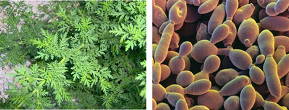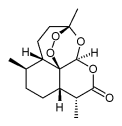In the search for new antibiotics, the so-called ‘natural’ medicines come into the picture again. Ousted (temporarily?) by the rise of chemistry, that laid the foundation for an entirely new branch of medicine. Based on simple substances. Developed in the second half of the 19th century, and risen fast afterwards. But natural medicines were never finally shut out. On the contrary, more than three quarters of the global population uses them. Because they have issues with industrial medicines (real or imaginary), out of conviction or tradition, or simply because people cannot afford the industrial medicines. In five episodes, we will investigate this area.
Project ‘100 years of antibiotics’
Episode 56. Bacteriophages, almost forgotten, but….
Episode 57. Phage therapy, a promising alternative to antibiotics?
Episode 58. Natural medicines
Episode 59. Phytomedicines, what does actually work?
Episode 60. Herbal antibiotics: garlic
Belief in progress
The status of industrial medicines rises together with the belief in progress. And falls later, as this conviction wanes. The belief in progress comes up in the industrial revolution. Quickly, the word ‘new’ gets a positive connotation. For instance as the motor car makes headway (early 20th century). For an interval, people even judge ‘artificial’ to be better than ‘natural’, witness the enthusiasm for nylons and plastics in the years after the Second Word War. But then the decline of all novelty sets in, at least in the eyes of the general public. And parallel to that movement, we see a revaluation of natural medicines, in particular in the industrialized countries. To which contribute the problems with antibiotics, often caused by overconsumption and abuse. An important cause of resistance. Not exactly the miracle drugs once expected. Could the balance tip over again to a preference for natural medicines?

At the moment, the body of literature on natural medicines is growing fast. Often from Asian authors – there, traditional medicinal practices have always remained in vogue. In particular the Indian and Chinese traditions are strong. Old knowledge is being passed on from generation to generation; it still lies at the basis of many treatments. Occasionally, such a treatment will find its way to Western medicine. This happened with the antimalarial drug artemisinin. Researchers found the recipe for this vegetal medicine in old Chinese texts. And it carried the leader of this research, Mrs. Tu Youyou, the Nobel Prize for medicine. Are there hidden treasures in the old texts that we now start to acknowledge? Will the rise of Asia, primarily of China, lead us the way? The major Western pharmaceutical companies have lost much of their credit. We will devote a number of episodes to natural medicines, and try to bridge the gap between traditional and modern medicine. Synthetic biology, in particular, seems to open up new vistas on medicines development.
Natural medicines, variable compositions
In a way, natural medicines are an entirely new scientific subject. The medicines themselves aren’t new; neither are their mechanisms. But in this new area, many common scientific practices appear not to be appropriate. Often, it is difficult to establish dose-effect relationships: how much of the medicine do we need for a medicinal effect? And the pathway towards official approval costs a lot. Generally, natural medicines will not, or just barely, be protected by a patent, reason why producers don’t like to follow that path. Artemisinin, treated earlier, is a notorious example. If we should like to both accept and regulate natural medicines, we need to look for other procedures.

And then we should acknowledge that a plant’s medicinal action will never be caused by a single compound. There are always related substances (often in varying concentrations) that will codetermine the effect. To what extent? We will almost never be able to answer that question, using present research procedures that try to establish simple relationships. Moreover, vegetal compounds will often be processed before being consumed. Processing them will almost certainly change the effect in the body. Will garlic’s medicinal properties be different if the cloves have been processed in the pasta sauce? Or do we need to eat them raw?

Seasonings
The issue ‘synthetic’ vs. ‘natural’ also arises outside the realm of medicines. Take the seasoning vanillin. Originally produced from the vanillin orchid, that grows in the tropical rain forests of Madagascar, Mexico and South-eastern Asia. But now largely substituted by a chemical product, made from guiacol (in fossil oil) or lignin (in wood). Now also produced from sugar, using modified microorganisms into which the genetic code for vanillin production have been inserted. Artificial vanillin now has a market share of 90%; natural vanillin is still in use, but exclusively in high-end products like expensive consumption ice cream and recipes in the haute cuisine. There is a major price difference as well: € 10-15/kg for the artificial product, vs. € 700-2,000/kg for the natural product. And there are differences in chemical composition. Artificial vanillin is at least 99.9% pure; occasionally, the natural product contains just 80% vanillin, the remainder being related compounds.
This issue has gained importance because of the resistance against genetic modification. But even if we disregard this problem, we can still pose the question what the advantage is of the natural product over the artificial one. Maybe a fuller flavour? A richer palette? That touches the question on artificial vs. natural medicines. Those extra compounds in vegetal products, do they add to the medicinal effect? Do they offer additional protection? Could they ward off resistance?
Difficult questions
Some authors hold that there are no publications on bacterial resistance against natural medicines, like vegetal antibiotics. But that doesn’t mean to say that the phenomenon doesn’t exist. Patients could simply revert to other medicines; perhaps they would visit their doctors again in order to ask for a recipe. Such issues are hard for science to resolve, if it should like to operate strictly experimentally; using controlled administration and double blind research. And without reverting to anecdotic communication or traditional knowledge! Will we be able to approach the natural vanillin more closely in its composition, because we now can produce vanillin from sugar using microorganisms – and perhaps change the product through small changes in their genetic codes?
Holism
This leads us to a wider issue: reductionism vs. holism. The issue whether we can fathom reality by dividing it into bits and pieces, and having a look at each of these components separately (reductionism). Or only by taking the whole into consideration and find patterns there (holism). Applied to medicinal science: can we treat medical conditions adequately by targeting a single pathogen and fighting it with a single medicine? Or should we employ a whole array of defence mechanisms, that will only have their effect in cooperation? In the battle against Covid-19 we witness this conflict in full fledge: vaccines and immunisation (holistic medicines) vs. antiviral medicines like remdesivir, that are designed specifically to eliminate the virus (reductionism). In episode 56 and episode 57, when we treated phages as antibiotics, this was an important issue.
We will go into this larger issue in a specific episode. It is not just medicinal science that struggles with this problem. It is at the heart of problems run into by the industries of insecticides and pesticides, and of agricultural chemicals. Almost all insecticides and pesticides are simple molecules, just like medicines. And we know for 10 years now, that plants thrive on a good balance between thousands, if not millions, of molecules and organisms in their immediate vicinity (the microbiome). Indeed, at times it seems that our insights into the health of plants are ahead of our medical knowledge of the human body. In plant research, we have more freedom to operate than in medical practice; that promotes that research. But possibly, the insights gathered there might assist us in a revaluation of natural medicines – a paradigmatic shift.
Sources:
Wikipedia: all names and products mentioned
Chinese geneeskrachtige planten, A.P. Dharma, De Driehoek Amsterdam, ISBN 906303164 (1982) (in Dutch)
